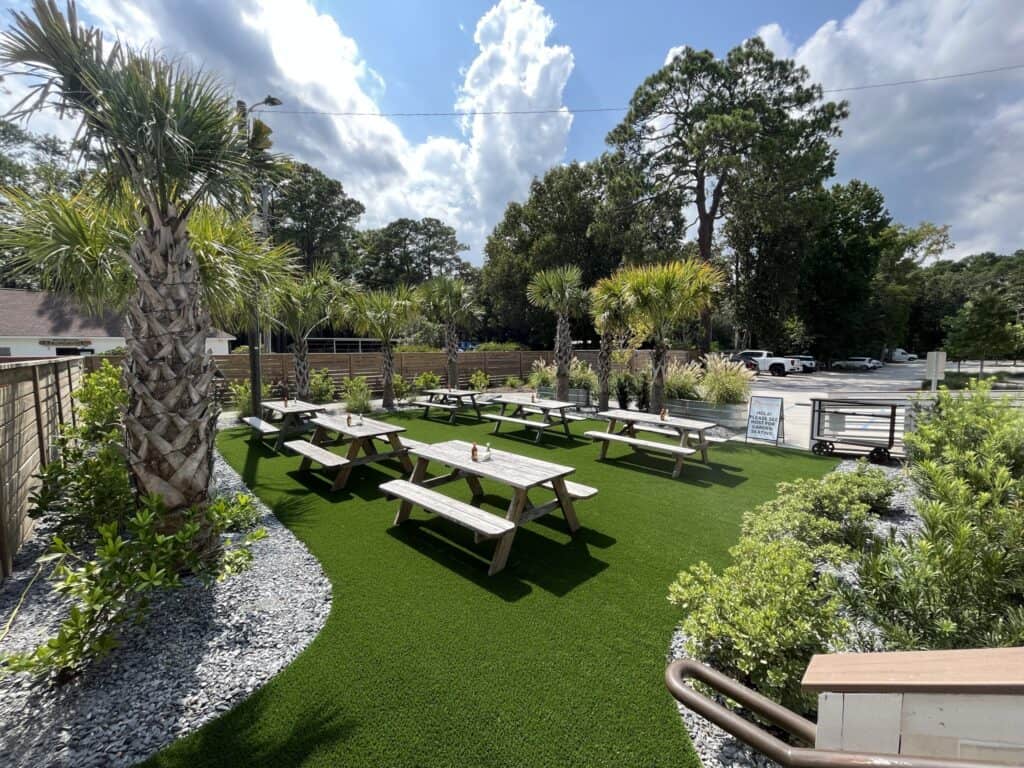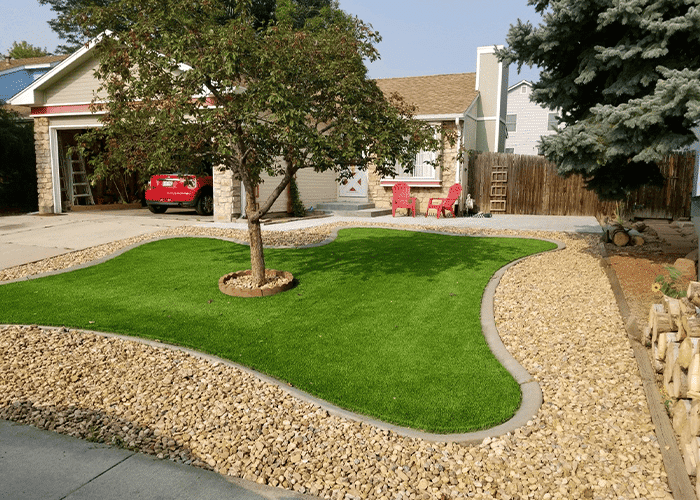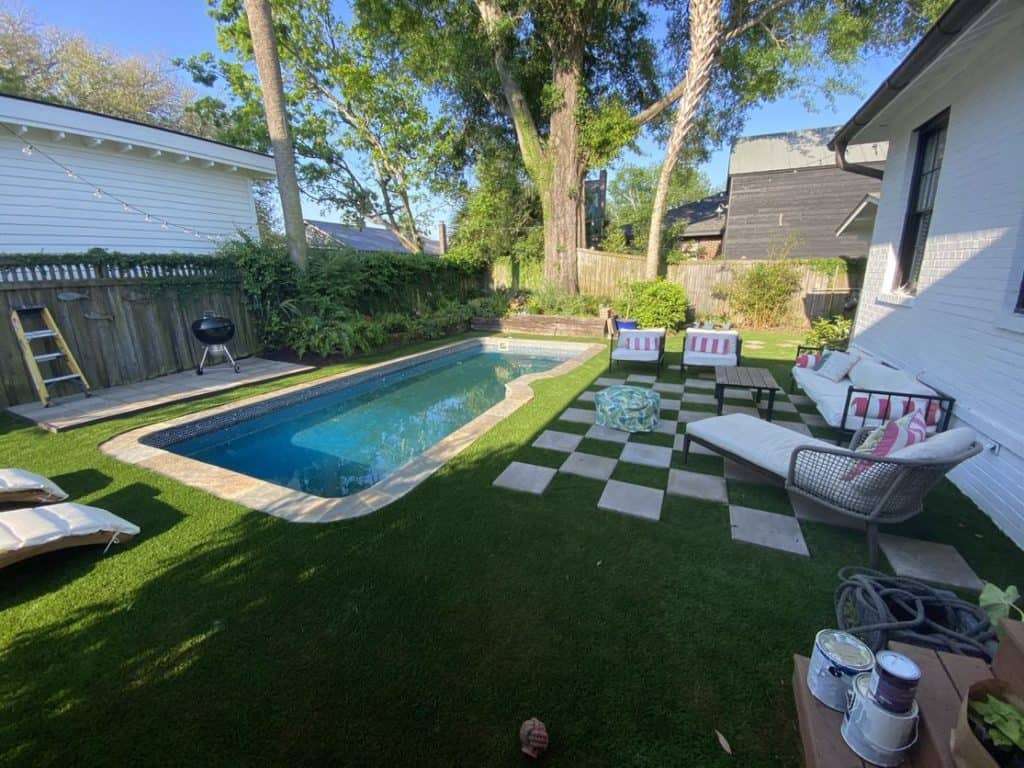Call us at 855-464-8873 or Schedule a Consultation
If you’re questioning whether turf is just too hot for your dog, you’re not alone. Pet owners are right to be concerned as the summer heat can crank up artificial grass temperatures to uncomfortable levels. We’ll tackle that burning question in this article, providing insight into heat risks for your canine and offer cool-down tactics to keep tails wagging, even on the hottest days.
Materials: Artificial turf made from plastic and rubber tends to retain more heat compared to natural grass. High-quality synthetic grass can mitigate some of this heat absorption, but the properties of the materials generally lead to higher surface temperatures.
Technologies: Modern artificial grass incorporates heat-resistant technologies such as specialized infills and moisture management systems. These advancements help reduce the heat buildup in turf, making it safer and more comfortable for pets, especially during hot weather.
Symptoms to Watch: Recognizing signs of heat distress in pets is important when they are active on hot artificial turf. Symptoms like excessive panting, seeking shade, and lethargy are signs that the surface may be too hot and potentially harmful, requiring immediate cooling actions or veterinary care.

Artificial turf, unlike natural grass, tends to retain more heat due to its usual composition of plastic and rubber. These materials lack the cooling benefits of living plant processes like transpiration, causing the surface to heat up, especially under the hot afternoon sun. The heat on artificial grass surfaces intensifies with soaring ambient air temperatures, as the materials absorb infrared rays and convert them into heat.
But the story doesn’t end here. Our modern artificial grass products are constructed with heat-resistant technologies. These technologies reduce the amount of heat absorbed and retained in your turf, making it safer for your pets.
Of course, the quality of synthetic grass plays a key role here. High-quality synthetic grass can stay cooler than poorer quality options. However, if you live in particularly warm areas, even the high-quality pet turf system can get hot during the summer. So you’ll need to plan and prep for the heat to keep your pets safe and comfy on your artificial grass.

The heat-retention properties of artificial turf are greatly influenced by the material quality and the type of infill used. Different materials and infills retain heat differently, and understanding this can help you choose the right turf for your backyard.
For instance, ProGreen’s artificial pet turf products enhance cooling by integrating heat-reducing infills, moisture management systems, or specialized coatings designed to mitigate heat buildup. Moreover, when choosing an option for your artificial lawn, opting for lighter colors and lighter weights in artificial grass can result in less heat retention and faster cooling times after exposure to sunlight.
It’s no surprise that artificial grass surfaces can get significantly hotter than natural grass. In direct sunlight, artificial turf can heat up to 150 degrees Fahrenheit, a stark contrast to the cooler temperatures typically reached by natural grass.
Unlike natural grass, which can regulate its temperature through water transpiration, synthetic turf lacks similar natural cooling mechanisms because—well—it’s not natural, of course. This is one of the reasons why a synthetic lawn can get hotter than a natural lawn, especially in really sunny climates.
Cooling synthetic turf is essential for the safety of your pet’s paws. When the turf gets hot, it can be uncomfortable and, in extreme cases, harmful for your pet.
There are simple ways to keep artificial grass cool. From introducing shade to spraying water from a garden hose, there are several things you can do to prevent your artificial turf from becoming a heat trap.

As a dog owner, it’s important to know when the temperature becomes just too much for your pet. A dog’s paw pads can be harmed when temperatures reach just 85 degrees Fahrenheit or higher. Surface temperatures over 120°F can burn dog paws.
A simple rule of thumb to determine if a surface is too hot for a dog to walk on is to place your hand comfortably on the pavement for ten seconds. If it’s too hot for your hand, it’s too hot for your dog’s paws.

When dogs play on hot surfaces, their behavioral changes can indicate heat distress. So, it’s important to monitor your dog carefully during the hottest summer days.
Initial signs of heat stress in dogs can be observed as seeking shade, reduced movement, restlessness, uncontrolled panting, and increased salivation. In severe cases, you might observe symptoms of heatstroke, such as confusion, excessive drooling, gums turning blue or purple, and dizziness. These severe symptoms require immediate veterinary intervention.
Here are some practical tips you can use to keep your pet cool on your artificial grass. These measures not only help reduce the temperature of the turf but also help create a comfortable environment for your pet.
These simple steps can prevent your artificial grass from heating up excessively and provide immediate relief. And let’s not forget the importance of preventive measures. Providing shade and water, limiting exposure during peak heat hours, and using cooling devices are all essential in preventing heat stress and paw burns. Remember, even if you have high-quality artificial grass, you should still do what you can to prevent harm from the heat.

Creating a shaded area is one of the most effective ways to lower the temperature of artificial turf surfaces. By blocking direct or reflected light, a shaded area can prevent the turf from heating up excessively.
There are several ways you can create a shaded area around your artificial grass. You can install garden umbrellas, canopies, or permanent shade structures. These structures cast shadows over the artificial grass and prevent it from overheating.
Investing in high-quality pet turf systems is another key strategy to keep your turf cool. These systems are designed with technologies to decrease heat absorption, providing a safer surface for pets during hot weather.
Our premium pet turf products are specifically engineered to minimize heat absorption by incorporating advanced materials and design features. Such features include:
Lighter color shades
Lower pile height
Wide-shaped blades
Increased space between blades for improved airflow
Routine cleaning of your artificial grass is another effective way to prevent heat build-up. Regular removal of debris is critical, as debris can retain extra heat.
Moreover, proper drainage is essential in preventing water accumulation, which can contribute to increased surface heat on artificial turf. With regular cleaning and proper drainage, you can create a cooler, more comfortable outdoor space for your pet.
At ProGreen, we specialize in pet-friendly turf that ensures the safety and comfort of pets. We select materials that are specifically designed to be gentle on pets’ paws and joints, making your furry friend’s experience on your artificial grass as enjoyable as possible.
Our innovative installation techniques also reduce the natural heat retention of artificial grass, creating a cooler surface for pets. These include superior drainage systems and deodorizing techniques to prevent pooling water and odors, enhancing the cleanliness and temperature regulation of the turf.
Is turf too hot for dogs? While artificial grass can get hot in the sun, with the right strategies and precautions, it can provide a safe, comfortable, and enjoyable environment for your pet. Understanding the science behind the heat build-up helps you know what to look for in artificial grass. Invest in high-quality pet turf systems from ProGreen to for your pet’s safety and comfort.